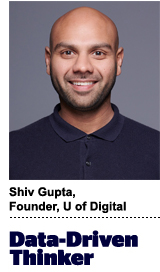“Data-Driven Thinking” is written by members of the media community and contains fresh ideas on the digital revolution in media.
Today’s column is written by Shiv Gupta, founder at U of Digital.
Ad tech is full of BS.
Why is that? Because when companies create confusion about their products, to make themselves sound more advanced than they actually are, they are able to sell more.
Ad tech has spawned so many different types of technologies over the years to accommodate the various environments, formats, and data sets, it’s become easy to overcomplicate and speak vaguely. Add to that a variety of different actors – consumers, publishers, advertisers, ad agencies, technology companies – with different motives, a wide range of value propositions, and the BS piles up quickly.
That’s why it’s absolutely critical for you to keep your BS detector on at all times, by being aware of situations in which you may encounter it, and by being ready with hard-hitting questions that will help you cut through it.
“AI”-powered solutions
You have surely come across many companies claiming they have “Artificial Intelligence”. Per John McCarthy, who first coined the term in 1955, AI is the concept of “… making a machine behave in ways that would be called intelligent if a human were so behaving.”
So you’re telling me that a run-of-the-mill DSP has the ability to imitate intelligent human behavior? If that was the case, why would they also have a team of traders investing tons of time and effort in the platform pulling manual optimization levers?
In 2016 Santanu Kolay, then SVP of engineering at demand side platform Turn, spelled out why AI in ad tech is mostly fiction. The average industry company has merely built an algorithm, which they are masquerading as AI.
Things haven’t changed much since then.
At last year’s Programmatic I/O conference, StackAdapt co-founder and CTO Yang Han spoke on how to sniff out whether true AI exists. He suggests asking questions about the AI’s accuracy (Show me situations in which it has been accurate in the past), adaptability (How does it adjust in real-time to market conditions such as shifts in supply and demand?), ability to cope with multiple KPIs (How does it juggle viewability goals with CPA goals with lifetime value goals?), and the way AI models are trained (What data is being used and how often is it refreshed?). If these questions can be answered articulately, then perhaps it’s real. If not, then it’s probably BS.
Scale
How often have you been told that a technology offers access to “millions” or “billions” of something, such as users, impressions or websites?
The reality is that access in this space is not hard to come by. It’s commoditized. It’s not unlike the financial markets, where you can access “billions of dollars of securities” by signing up for a free E-Trade account.
In response, one should ask: Have you actually demonstrated your ability to utilize that access effectively?
A DSP will say they can access billions of impressions, but how many impressions did they actually bid on, and how many did they win last month? Do they choose not to send bids for every impression because they can’t afford the server costs? What would happen to their platform if they were to increase their volume?
This line of questioning will help you understand the reality of their scale.
Causation vs. correlation
Another classic ad tech trick is claiming causation between variables vs. mere correlation.
Think how often you’ve heard “our engine drives great performance” when in reality, the engine does a great job of merely correlating with “performance.” Serving up ad impressions that can then be tied to conversions doesn’t mean those impressions actually caused those conversions to take place.
Smart marketers have started to pick up on this kind of BS. To understand the real value of advertising, they seek to measure causation. This is why incrementality testing has become such a valuable measurement tool.
Push your partners on this.
So what?
The list of BS in this industry goes on and on. Transparency, data usage, brand safety, fraud, you get the point. It’s always possible that a product can help you achieve your goals, despite the company’s attempts at misdirection. But if they are not forthright with you, how can you know what you’re buying, and how can you ever build a trust-based partnership?
By asking tough questions and thinking critically, you can ensure that you don’t get duped. Here are our tips:
- Ask people to “”show” not “tell”
- Ask people to talk in plain English; if they can’t explain it in plain English themselves, then it’s probably not real
- Ask them to apply what they are offering to your business challenges specifically, and play out the execution of it
- Keep educating yourself
- Realize that you know more than you think you do!
Don’t fall victim to the BS!
Follow U of Digital (@UofDigital) and AdExchanger (@adexchanger) on Twitter.















